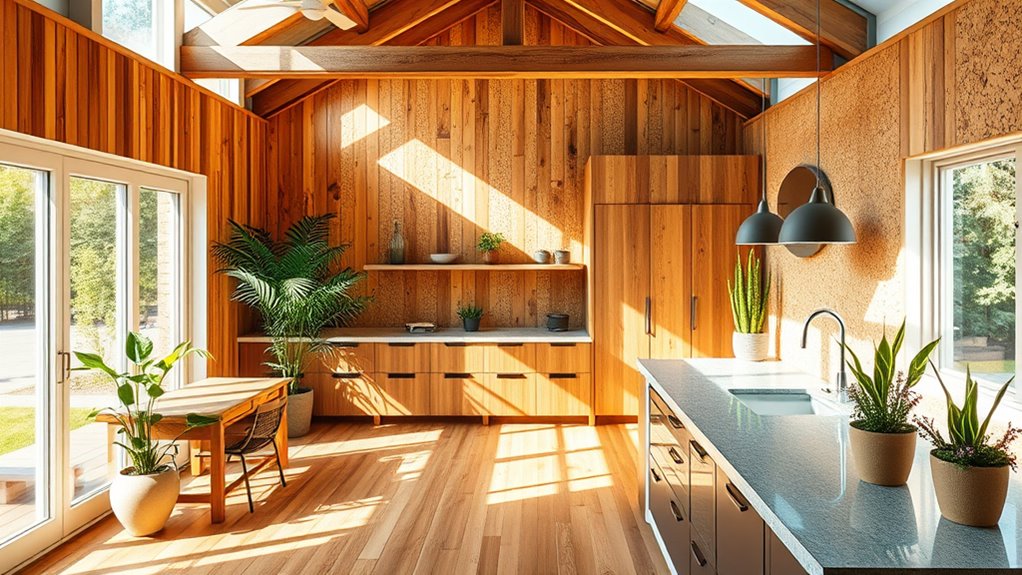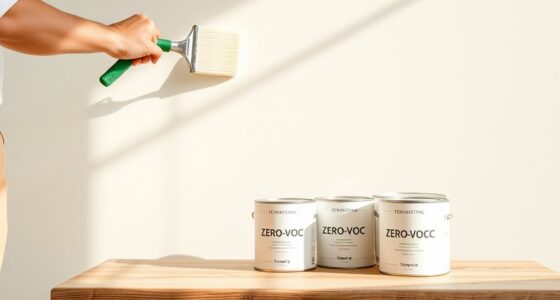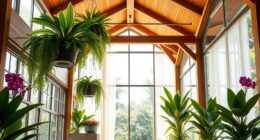Discover seven eco-friendly materials that can transform your home, from ancient yet effective cob made of soil, water, and straw, to innovative cement alternatives like Ferrock and AshCrete crafted from recycled waste. You can use fungi-based Mycelium for insulation, upcycled newspaperwood for unique surfaces, recycled plastic for durable components, reclaimed steel for strength, and plant-based foams like Hempcrete for eco insulation. Keep exploring to find out how these sustainable materials can redefine your space.
Key Takeaways
- Natural materials like cob and reclaimed steel reduce environmental impact and enhance home durability.
- Recycled waste, including newspaperwood and plastic, supports circular economy and waste reduction.
- Innovative cement alternatives such as Ferrock and AshCrete lower carbon emissions and utilize recycled materials.
- Fungi-based (mycelium) and plant-based insulations improve energy efficiency and promote sustainable building practices.
- Eco-friendly options like hempcrete and recycled plastics contribute to healthier indoor environments and long-term sustainability.
Cob: The Ancient Natural Marvel
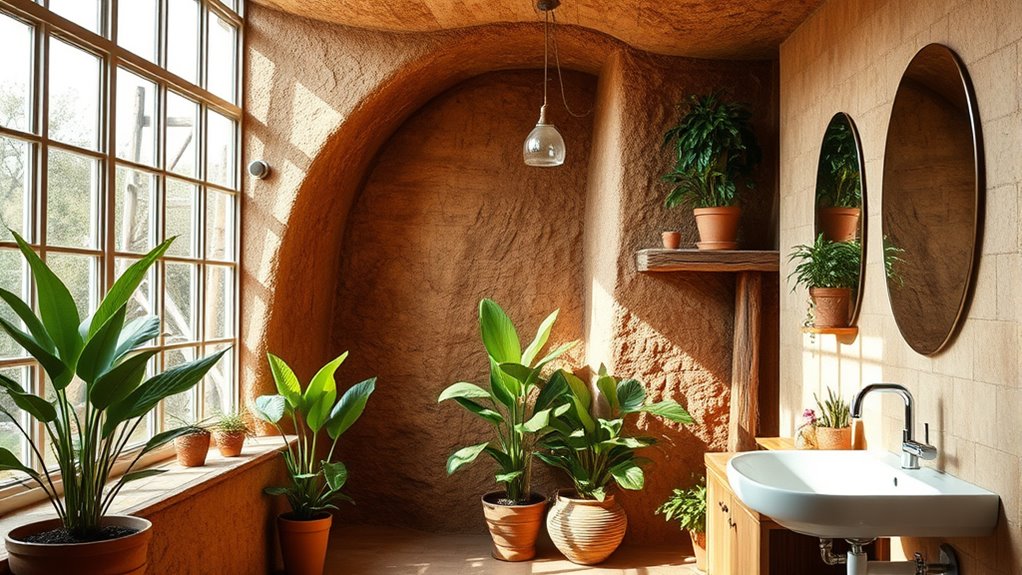
Cob is an ancient and natural building material that has stood the test of time for over 10,000 years. As a natural building material, it’s made from a blend of subsoil, water, straw, and sometimes lime, forming a versatile organic material. Its eco-friendly and sustainable qualities make cob a popular choice for eco-conscious builders. Since it’s a renewable resource, you can source the ingredients locally, reducing environmental impact. Cob offers natural insulation, helping your home stay warm in winter and cool in summer, which makes it energy-efficient. Its organic nature promotes healthier indoor air quality while minimizing the need for artificial heating and cooling. Additionally, cob’s cost-effective nature makes it accessible for a wide range of projects, further enhancing its appeal. The use of cob also aligns with sustainable building practices, making it an environmentally responsible choice. Its durability and ability to adapt to various architectural styles ensure that cob remains a timeless building material for generations to come. As a versatile construction material, cob can be shaped into various forms, allowing for creative architectural designs. With its timeless appeal and environmentally friendly profile, cob remains a smart, natural option for sustainable, natural building projects.
Ferrock and Ashcrete: Cement Alternatives Made From Recycled Waste
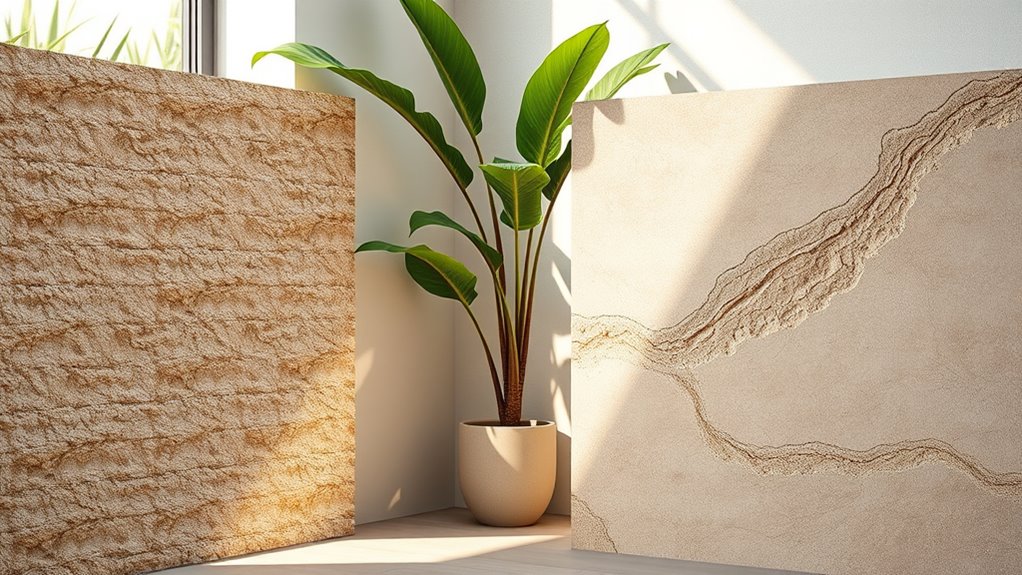
As the construction industry seeks sustainable alternatives to traditional cement, Ferrock and AshCrete stand out by transforming waste into valuable building materials. These eco-friendly options use recycled materials like waste steel dust and ground glass silica, making them true concrete alternatives that promote a circular economy. Ferrock is a carbon-negative material that absorbs CO₂ during curing, becoming five times stronger than Portland cement and suitable for demanding applications like marine structures. AshCrete, composed of 97% recycled content including fly ash, offers durability while considerably reducing carbon emissions. Both materials help advance sustainable building practices by utilizing waste byproducts and decreasing reliance on virgin resources. Recycled materials play a crucial role in minimizing the environmental footprint of construction. Incorporating innovative eco-friendly building materials like Ferrock and AshCrete not only reduces environmental impact but also encourages industry-wide adoption of sustainable practices, fostering a greener, more sustainable future. Additionally, their use can inspire further innovations in green construction and promote the development of eco-conscious building standards. These materials exemplify how waste recycling can be directly integrated into modern construction projects to achieve greater sustainability.
Mycelium: Fungi-Based Insulation and Building Material

Mycelium, the root-like structure of fungi, is emerging as a sustainable alternative for insulation and building materials. This fungi-based material is eco-friendly, biodegradable, and renewable, making it an ideal choice for eco-conscious construction. You can grow mycelium into dense, lightweight blocks that serve as effective insulation and structural components. Its natural properties include water resistance, fire resistance, and impressive strength—sometimes exceeding traditional materials like concrete. The cultivation process is simple: inoculating organic substrates like sawdust or agricultural waste with fungal spores, which then grow into solid bricks within days or weeks. Additionally, biodegradable building materials are gaining popularity for their minimal environmental footprint. Choosing mycelium helps reduce construction waste and lowers carbon emissions, supporting sustainable building practices while providing durable, eco-friendly options for your home. Furthermore, innovations in sustainable construction demonstrate how eco-friendly materials like mycelium can lead to cost-effective and environmentally responsible building solutions. Incorporating these materials can also facilitate energy efficiency in your home by providing better insulation. As awareness grows, more builders are exploring fungi-based materials for their unique benefits and sustainability.
Newspaperwood: Upcycled Paper for Sustainable Wood-Like Surfaces
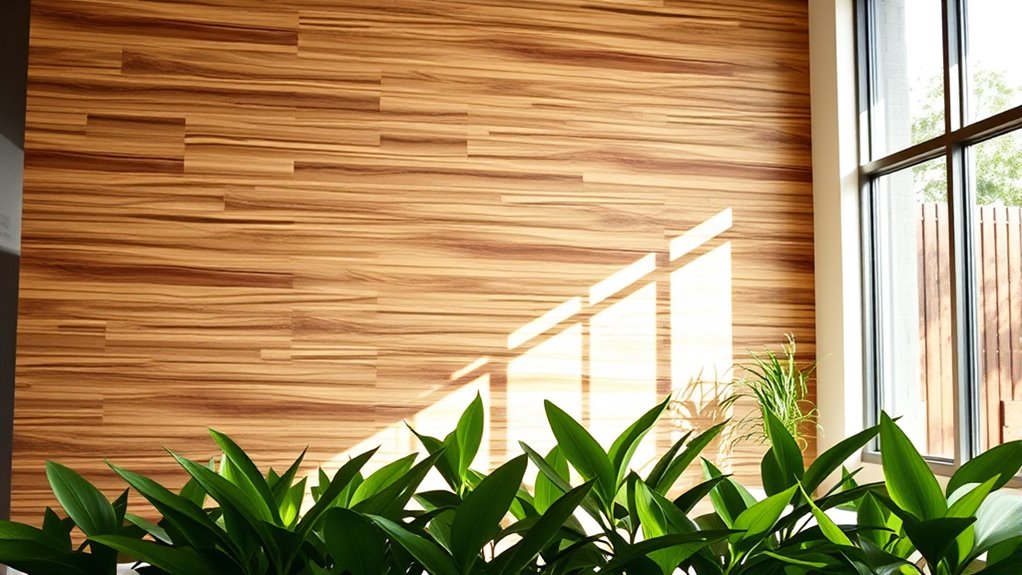
You can explore how newspaperwood exemplifies eco-friendly material innovation by transforming waste into durable, wood-like surfaces. Its rustic, weathered appearance offers a unique aesthetic that enhances interior design. Plus, repurposing paper reduces waste and lessens the demand for new timber, supporting a circular economy. Using upcycled paper in construction also minimizes the environmental footprint associated with traditional wood harvesting. Incorporating sustainable materials like newspaperwood can significantly reduce your home’s ecological impact while adding distinctive character. Additionally, innovations such as electric bikes demonstrate how alternative energy sources can further promote sustainability in everyday life. Embracing eco-friendly building materials can further improve your home’s sustainability and reduce overall environmental impact.
Research indicates that utilizing renewable resources in building projects is essential for long-term environmental health.
Eco-Friendly Material Innovation
Innovative eco-friendly materials like Newspaperwood are transforming sustainable construction by repurposing waste into functional surfaces. Made from recycled newspapers bonded with eco-friendly adhesives, it exemplifies sustainable building materials that support a circular economy. This upcycled waste reduces landfill overflow and minimizes energy consumption during manufacturing, resulting in low energy production. Newspaperwood creates a durable surface ideal for flooring, furniture, and wall paneling, combining rustic aesthetic with practicality. Its use enhances indoor air quality by avoiding harmful chemicals found in traditional materials. By integrating Newspaperwood into your home, you contribute to green home design, promoting eco-conscious choices. Additionally, understanding soil moisture check helps highlight the benefits of using sustainable materials like Newspaperwood in construction. This material showcases how innovation in eco-friendly solutions can redefine the future of sustainable building, turning waste into beautiful, sustainable surfaces.
Unique Wooden Aesthetics
Have you noticed how Newspaperwood brings a unique, rustic charm to modern design? This innovative material uses recycled paper, compressed with eco-friendly adhesives, to create surfaces that mimic traditional wood grain texture. Here are three reasons you’ll love it:
- Its rustic aesthetic adds natural charm to any space, blending sustainability with style.
- The low energy processing and waste reduction make it a smart choice for sustainable building.
- As a biodegradable material, it supports environmentally friendly initiatives by repurposing waste paper and reducing demand for virgin wood.
- Its carbon footprint is significantly lower compared to traditional wood, making it an even more eco-conscious option.
Newspaperwood’s textured surface offers a weathered look that’s both eco-conscious and visually appealing, making it perfect for those seeking a natural, environmentally friendly alternative to conventional wood.
Waste Recycling Benefits
Did you know that recycling newspapers into newspaperwood considerably benefits the environment? By using recycled waste, you support upcycling and reduce the amount of recyclable materials heading to landfills. This eco-friendly material requires less energy than processing new wood, making it a smart choice for sustainable building. Through material recycling, you help divert waste from landfills, contributing to environmental conservation. Newspaperwood’s durability and natural look make it ideal for interior surfaces, while its production promotes waste reduction. Choosing newspaperwood not only adds aesthetic value but also supports the circular economy by transforming waste into functional, beautiful materials. Every piece of newspaperwood you use helps lessen landfill volume and fosters a greener, more sustainable future.
Recycled Plastic: Transforming Waste Into Durable Construction Components

Recycled plastic offers a sustainable solution by turning waste into strong, long-lasting building materials. Its environmental benefits include reducing landfill and ocean pollution while cutting carbon footprints considerably. With versatile applications like bricks, panels, and outdoor furniture, recycled plastic is transforming construction in eco-friendly ways.
Environmental Benefits of Recycled Plastic
Transforming waste into durable construction components offers substantial environmental benefits. By using recycled plastic in building materials, you help reduce plastic waste that can take up to 1,000 years to decompose, preventing long-term pollution. Incorporating recycled plastic products like lumber and bricks minimizes reliance on virgin resources, lowering carbon emissions associated with manufacturing. These eco-friendly materials are resistant to rot, insects, and weather, making them highly durable. Additionally, manufacturing with recycled plastic can cut greenhouse gas emissions by up to 95% compared to traditional materials like concrete and wood. By choosing recycled plastic, you actively support sustainable building practices, divert millions of tons of plastic waste from oceans and landfills, and considerably reduce your carbon footprint.
Versatile Building Applications
By incorporating recycled plastic into building projects, you can create a wide range of durable and versatile components, from panels and bricks to lumber. These eco-friendly building materials enable versatile applications such as fencing, decking, and outdoor furniture. Recycled plastic considerably reduces landfill contributions by repurposing waste that would take up to 1,000 years to decompose. Thanks to its weather resistance, rot, and pest resistance, recycled plastic is ideal for outdoor use. Its recycled content not only supports sustainability but also speeds up construction with faster laying times. Below is a quick overview of some common applications:
| Material | Features | Uses |
|---|---|---|
| Recycled plastic panels | Weather resistant, durable | Wall cladding, partitions |
| Bricks & tiles | Eco-friendly, quick to install | Outdoor paving, fencing |
| Lumber | Sustainable, pest resistant | Decking, garden furniture |
Reclaimed Steel: Strength and Sustainability in Metal Construction
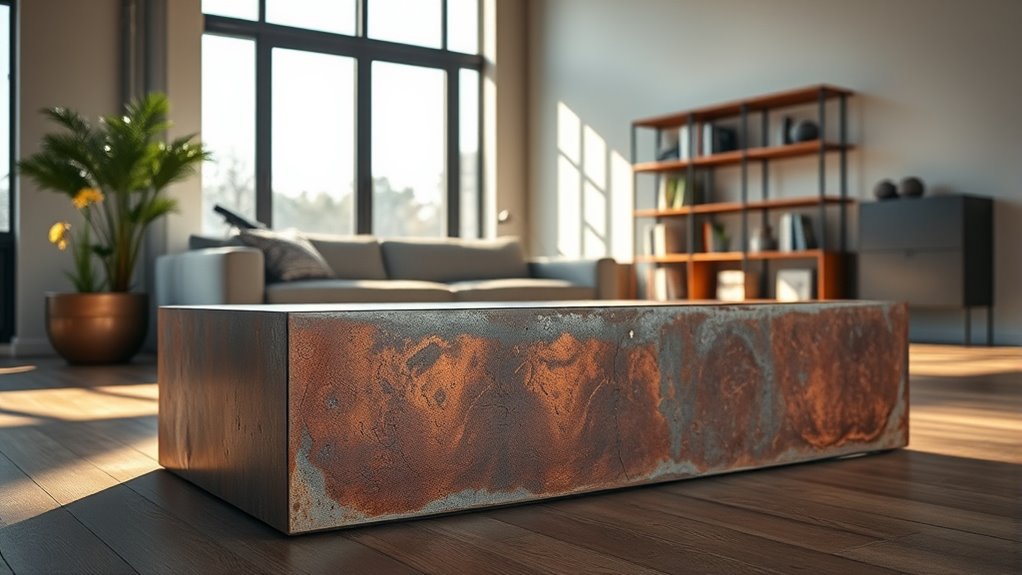
Reclaimed steel offers a powerful combination of strength and sustainability that makes it an ideal choice for modern construction. By using recycled steel, you support eco-friendly building materials that maintain structural integrity while reducing environmental impact. Here are three key benefits:
- Low Energy Production: Recycled steel uses up to 75% less energy, lowering greenhouse gases and supporting green construction.
- Durability & Corrosion Resistance: Its durability ensures long-lasting structures with minimal maintenance.
- Waste Reduction: Incorporating recycled steel helps divert waste from landfills, contributing to sustainable development.
Choosing reclaimed steel means you’re building with a material that’s both strong and eco-friendly, making your projects more sustainable and aligned with green building practices.
Hempcrete and Plant-Based Foams: Green Insulation With a Modern Edge
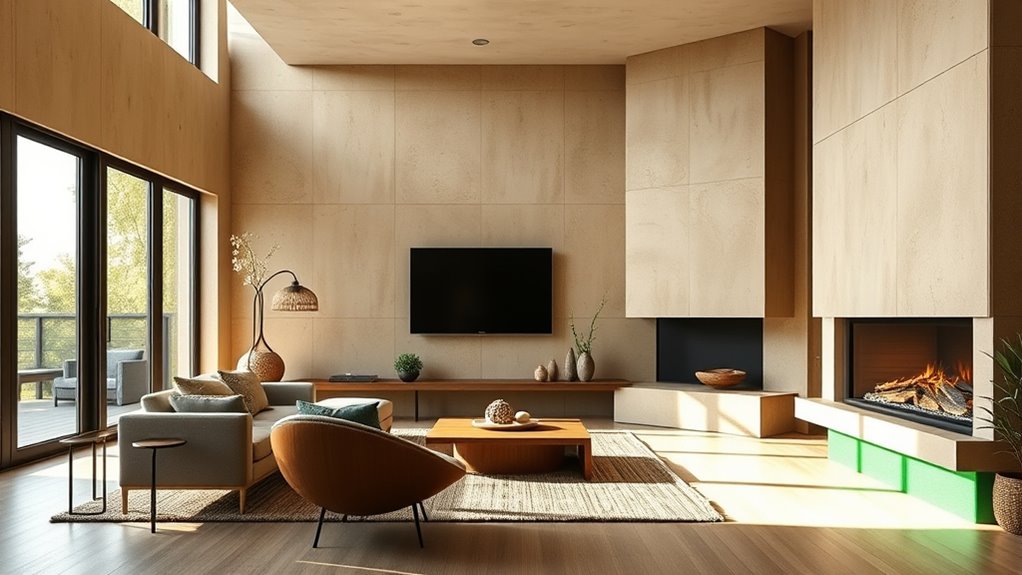
As sustainable building practices gain momentum, hempcrete and plant-based foams emerge as innovative insulation options that combine eco-friendliness with modern performance. Hempcrete, made from hemp fibers, lime, and water, offers natural insulation, pest resistance, and is carbon-negative by absorbing CO2 during curing. Plant-based polyurethane foams, derived from renewable sources like hemp, kelp, and bamboo, provide energy-efficient, superior thermal resistance—up to 25% better than fiberglass—and resist mold and pests. These biodegradable, low-VOC materials support an eco-friendly home and reduce environmental impact. They also regulate humidity naturally and are fire-resistant. Incorporating these green insulations advances sustainable building materials, helping you create a healthier, more energy-efficient living space.
| Material | Benefits | Characteristics |
|---|---|---|
| Hempcrete | Carbon-negative, natural insulation | Biodegradable, breathable, fire-resistant |
| Plant-based Foams | Superior thermal resistance, mold resistant | Renewable, energy-efficient |
Frequently Asked Questions
What Is the Most Eco-Friendly Material to Build a House With?
You might think building with traditional materials is enough, but picture transforming your home into a green fortress. Hempcrete stands out as the ultimate eco-friendly choice—absorbing carbon, insulating perfectly, and renewing faster than you can imagine. It’s like giving your home a gust of fresh, sustainable air. By choosing hempcrete, you’re making a bold statement for the environment, ensuring your house is as eco-conscious as it is beautiful and resilient.
What Is a Sustainable Material to Make a House Out Of?
When choosing a sustainable material for your house, consider options that reduce environmental impact. Recycled steel is a great choice since it uses up to 95% less energy than new steel. Alternatively, cob offers an eco-friendly, energy-efficient building method made from natural materials. Bamboo is another excellent option because it grows rapidly and renews quickly. Reclaimed wood and cork also provide sustainable, beautiful, and functional solutions for your home.
What Is the Most Eco-Friendly Thing?
Think of the earth as a delicate garden, and you’re the gardener tending to its future. When you ask what’s most eco-friendly, you’re seeking the purest form of harmony with nature. Reclaimed wood, bamboo, cork, recycled steel, and mycelium all symbolize sustainability. Each choice preserves resources, reduces waste, and nurtures the environment. By choosing these, you’re planting seeds for a greener, healthier world, echoing nature’s resilience and beauty.
What Is More Eco-Friendly Than Concrete?
When you ask what’s more eco-friendly than concrete, consider materials like Ferrock, which absorbs CO₂ during curing and is stronger than Portland cement. Recycled steel offers a durable, low-energy alternative, while Mycelium bricks are biodegradable and emit zero emissions. Hempcrete provides natural insulation and is carbon-negative. These options reduce environmental impact, making your home more sustainable without sacrificing strength or durability.
Conclusion
So, next time you’re about to toss that plastic bottle or scrap some old newspaper, remember—you’re actually helping build a greener future. Who knew that waste materials could be so stylish and sustainable? Instead of contributing to pollution, you can now transform trash into these eco-friendly marvels. It’s almost ironic—your trash might just be the next big thing for your home’s sustainability. Embrace these materials and make your home a true eco-champion.
